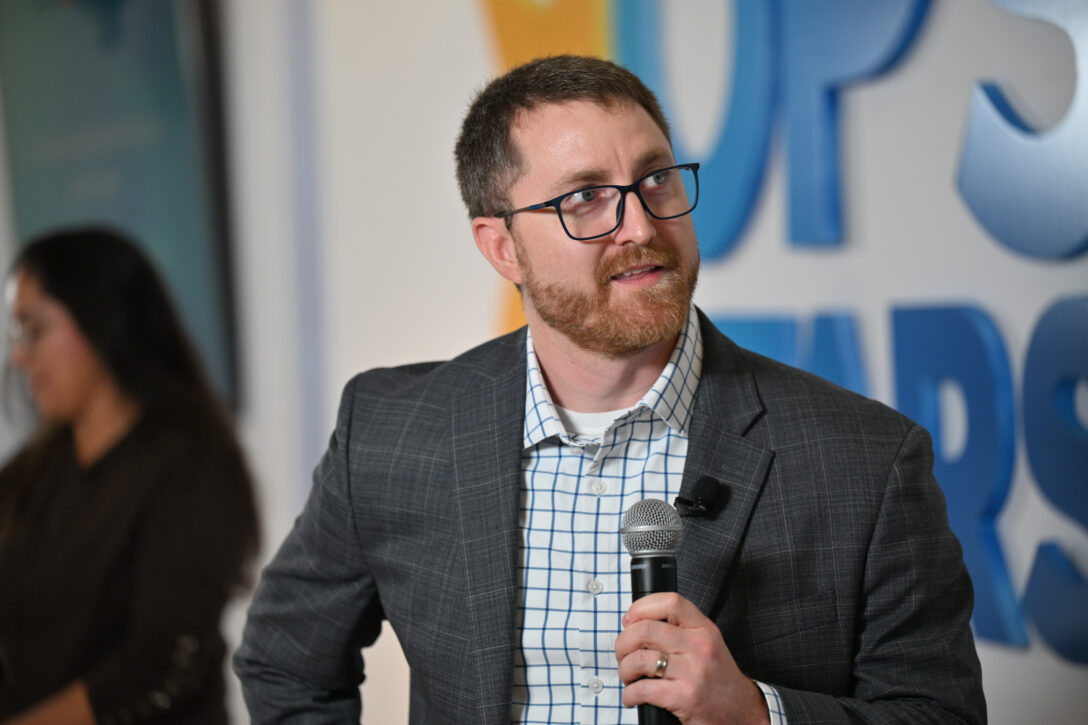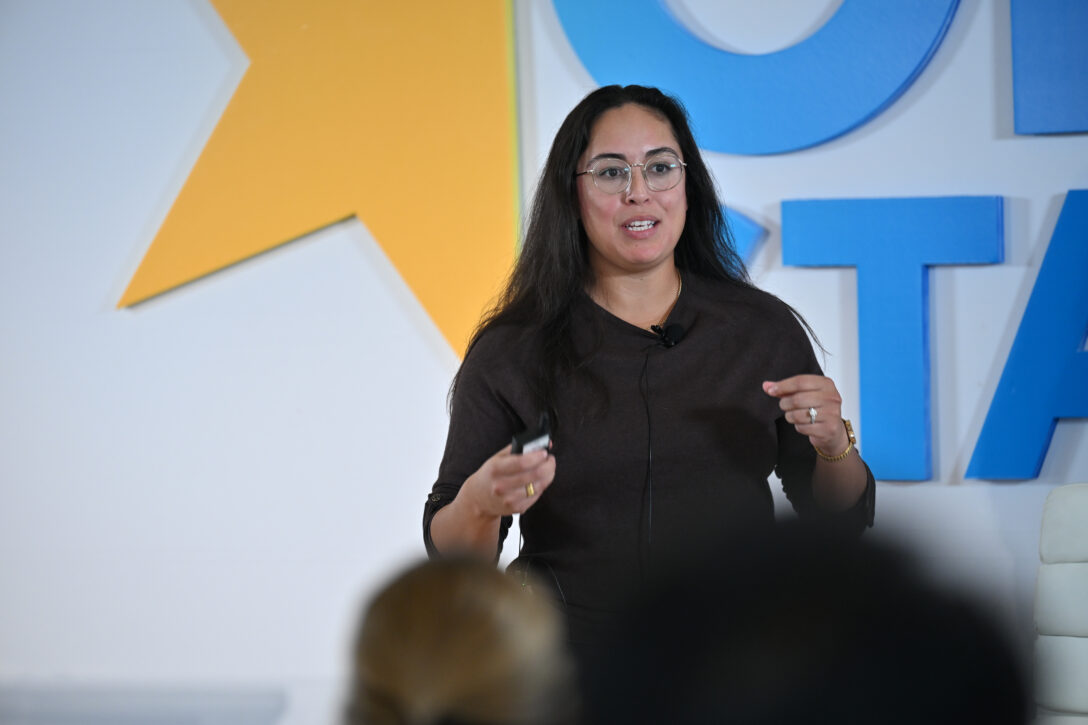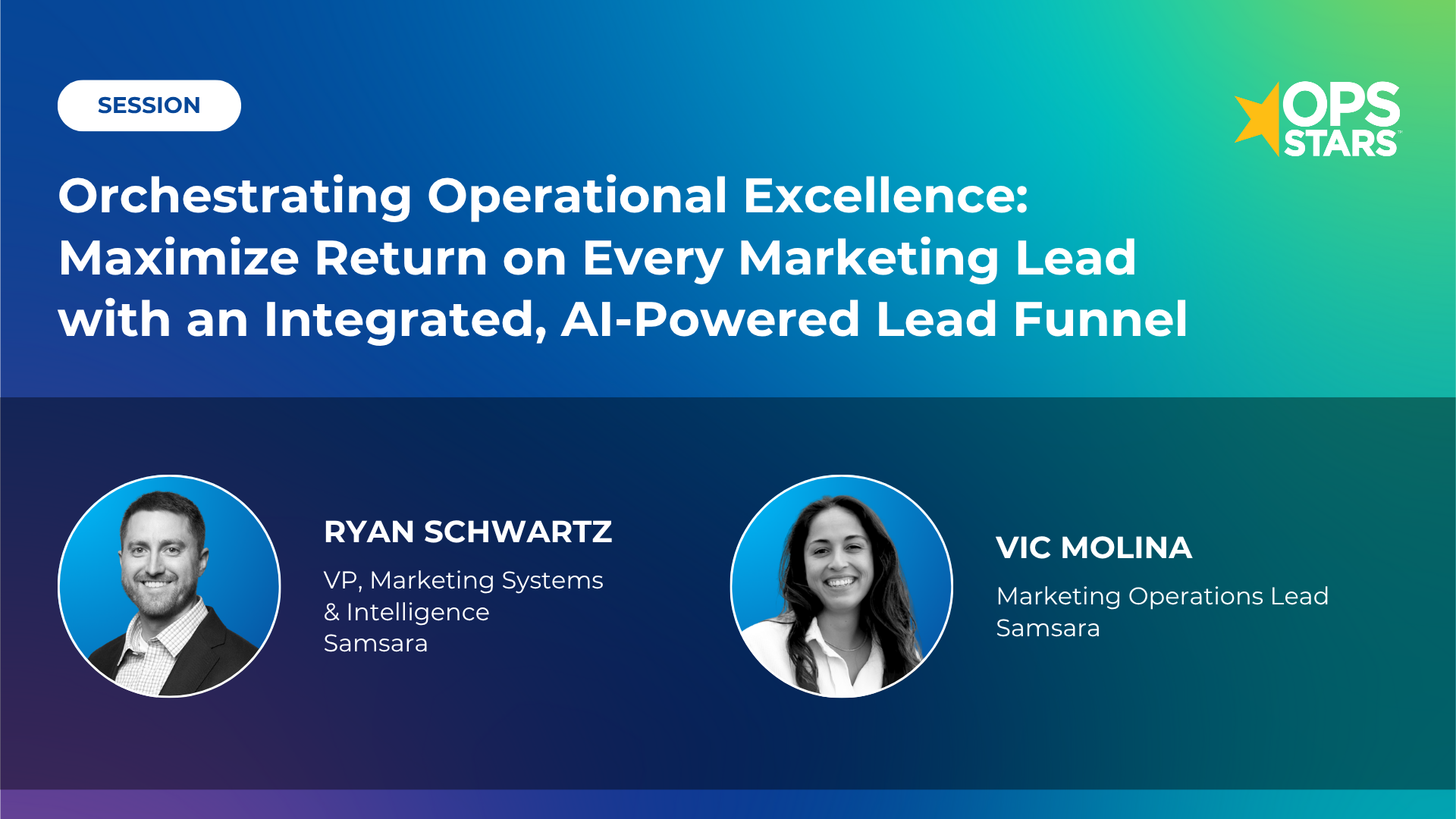Summary
Samsara’s Marketing Systems & Intelligence leaders walk through how they redesigned their inbound funnel using an Intelligence Team model, LLM‑based propensity scoring, a homegrown ingestion service, and LeanData routing. This session is ideal for RevOps, Marketing Ops, and Sales Ops leaders under pressure to improve conversion, reduce handling time, and scale personalization. The core takeaway: pair AI with disciplined GTM orchestration to turn every qualified hand‑raise into a fast, relevant sales engagement.
Key Takeaways
- Stand up a Marketing Intelligence function to own AI use cases, tooling, and experimentation across the funnel.
- Use LLMs with rich “account/contact memory” to score propensity and filter out low‑quality or fake leads.
- Centralize enrichment, dedupe, and scoring in a lightweight ingestion layer to keep end‑to‑end processing under seconds.
- Combine that layer with LeanData orchestration to consistently hit aggressive speed‑to‑lead SLAs and give Sales confidence in routing.
- Generate on‑brand, hyper‑personalized follow‑up with internal knowledge (e.g., Slack‑based assistants) plus external research.

Speakers
Ryan Schwartz, Vice President, Marketing Systems & Intelligence, Samsara
Ryan built the Marketing Intelligence function at Samsara, unifying data engineering, AI engineering, and MOPs to unlock new pipeline and faster speed‑to‑lead.
Victoria Molina, Marketing Operations Manager, Samsara
Victoria (Vic) leads lead‑funnel optimization, from enrichment and scoring to sales enablement and personalization at scale.
What You’ll Learn
Q: How can LLMs improve lead quality beyond traditional scoring?
A: Feed the model a narrative “memory” built from Salesforce activity, campaign data, intent, and conversation summaries, then prompt for 1–5 buy/renew/expand propensities with reasons. Pair with a Databricks check that flags “not a real person/company,” gibberish, and obvious test entries to protect ADR time.
Q: What’s the fastest way to shrink time from form‑fill to first call?
A: Move enrichment, dedupe, and scoring out of your marketing automation platform‑to‑CRM tangle into a single ingestion service so everything runs in parallel, then route with LeanData. Teams reported high‑priority contacts called within five minutes once this architecture was in place.
Q: How do you scale personalized follow‑up without hundreds of static nurtures and sequences?
A: Use an internal AI assistant (e.g., Slack bot trained on trusted content) plus a sequencing tool that auto‑generates multi‑touch outreach tailored to the account and contact. Reps review, tweak, and launch, staying on brand while cutting research time from ~30 to 45 minutes to a few minutes.

Session Transcript
Ryan Schwartz
Can you hear me? Okay, is this better? Okay, I’ll start over. All right. I’m Ryan. I’m the Vice President of Marketing Systems and Intelligence at Samsara, and I just want to first thank you for coming to this session. I’m really excited to share some real practical examples that you can hopefully be inspired by, take back, and use as reference. We’ve built some really cool stuff over the last several months.
First, just a quick intro on Samsara. We are really the pioneer of providing a connected operations platform to people, their devices, and the systems that power our global economy. Think industries like transportation and warehousing, construction, and field services—these types of large, complex, physical operations. We provide technology that helps them be safer, more efficient, and increase their sustainability efforts. I’m going to let Vic introduce herself. She’s really the mastermind behind a lot of what we built.
Vic Molina
I’m the Operations Manager at Samsara, and my team specifically focuses on lead funnel optimization. We’ve been really excited about the changes we’ve been able to make over the last nine months and excited to share them with you. As Ryan said, hopefully there are some takeaways for you to take back to your orgs and really make an impact. I’ll pass it back to Ryan to walk through the agenda.
Ryan Schwartz
Okay, cool. So first, I want to introduce the concept of a marketing intelligence team. What is the objective of a marketing intelligence team? What are their capabilities? We’ll talk through that, and I’m going to give you some real examples of things that we built, and then we’ll show you a little bit of what’s ahead.
So, what is a marketing intelligence team? Is this just another way of saying, “use AI more”? I mean, yes, kind of—but it’s really thinking through what resources go into this team. How do you solve intelligence challenges going forward? I think it’s a mixture of marketing operations professionals, data engineers, AI engineers, and data scientists. It’s a combination of building technology as well as buying technology to solve these problems.
This team is also responsible for a massive mental shift, which is probably the most complicated part of it. It’s a constant state of expansive thinking. You have to be comfortable not being emotionally connected to everything you built in the past, constantly wondering what the better way of doing it is, and being okay with change management. You’re thinking through the art of the possible—if I were to do it over from scratch today, how would I do it?
Lastly, I think this is a team that can be a leading force within the organization for unlocking new capabilities, new paths to pipeline, new revenue, and better customer experiences. If you don’t have an intelligence team, you’re missing out. It doesn’t have to be a large team—it could be a small tiger team—but it should be responsible for driving AI initiatives throughout the organization.
So, how did we get started with this? First, we defined a marketing intelligence team. We also defined AI champions across the marketing organization. Then we asked, “Where could we make a material impact that could have a lasting effect within the team?” We identified 12 core primary marketing capabilities where material changes could have significant impact. We’ll talk about a few of these, focusing on the lead funnel that Vic did such an awesome job on. I’ll hand it over to her.
Vic Molina
To really showcase the impact of marketing intelligence in action and leading with innovation, we wanted to walk through a specific case study about our lead management system. While lead management covers all 12 of these buckets, for this conversation we’ll focus on data enrichment, lead management, sales enablement, and personalization at scale.
By focusing on these three areas, we’ve made significant improvements within Samsara, and it’s only the beginning—setting the groundwork for future optimizations.
The first area is identifying high-quality prospects and data quality. If we’re able to identify who our highest-value prospects are and help the sales team prioritize these leads, it makes them more efficient. And this is more than just figuring out if the phone number or email works—it’s about predicting who the right person is at a real account that’s going to buy Samsara and has that use case.
The second piece is ensuring those high-quality prospects get to the sales team quickly and efficiently. There’s a lot that has to happen before routing a lead, including enrichment, scoring, and deduplication. We wanted to make that system super efficient and make the handoff between sales and marketing quick and easy across the business.
Once we identify and route high-quality prospects, the next step is outreach—personalization at scale. We wanted to give our sales team confidence when picking up the phone, and we also wanted to ensure potential customers have a white-glove experience, especially in the age of AI.
By focusing on these three buckets, we’ve seen significant improvement across the lead funnel—better MQL-to-opportunity conversion, increased pipeline, and, most importantly, a huge improvement in the number of leads attempted within a very aggressive SLA.
Let’s dive into these three buckets, starting first with lead quality.
Ryan Schwartz
Okay, real stuff now. We asked ourselves, if we built these models today, how would we do it? We’d done traditional lead scoring, account scoring, maybe using marketing automation platforms or data science models or purchased technology. That’s great—but how would this look in the age of AI?
Could an LLM actually be used as a propensity model? So first, it has to start with context. We created what we call account memory or contact memory. It’s a field that takes all the Gong conversations, Salesforce data, campaign and web activity, all the signals and intent—and puts them into a long text field with all that context.
Then we created a mega prompt that gives specific instructions to create a propensity-to-buy, propensity-to-renew, and propensity-to-expand score from one through five, along with reasons and context. We compared it to our data science models—and surprisingly, it outperformed them. And we know how to build data science models, so this was an awesome unlock. We’ve migrated all of our propensity models to an LLM-based approach.
Vic Molina
Even with inbound leads where we don’t have much account or contact research, LLM modeling can still make a big impact in identifying net-new prospects and intent.
We have an LLM model embedded in a Databricks notebook that tries to answer: is this a real person at a real company? We also check that the phone number works, the email doesn’t bounce, and more—but beyond that, can we identify which leads are highest quality and worth routing to our ADR team?
This model works across three main areas:
- Common keywords like “test” or “no interest.”
- Gibberish or random text that’s hard to detect with regex.
- Company heuristics, like a company name that’s too short or identical to the contact’s name.
All of this happens on the backend, so we’re not being overly restrictive with forms. We still capture submissions but can control thresholds for routing to sales. Leads that don’t meet the threshold go into nurture journeys or other engagements to test validity without wasting sales resources.
Both of these approaches—LLM scoring and backend filtering—help us identify high-quality prospects. The next goal is to make sure they’re actioned as quickly as possible.
In the past, routing involved complex connections between your marketing automation platform and CRM, which caused delays and limited customization. So, we built an internal ingestion tool called Notre Dame. This tool is the center for all of our inbound leads, processing hundreds per day. Matching, deduping, enriching, and scoring all happen in one system in under 17 seconds.
We plug into third-party APIs for enrichment, use that data for scoring, and it’s consistent and reliable for Samsara’s needs. If we can process leads quickly, that’s where LeanData comes in—to get them into reps’ hands fast.
Ryan Schwartz
This is where having engineers as part of the intelligence team is essential. It allows you to build tools like Notre Dame. If your engineers are siloed in another org, I encourage you to change that.
Notre Dame was huge, and LeanData was our partner for routing. It’s a combination of building and buying. LeanData was absolutely essential to deliver the SLAs we wanted.
Our buyers will pick up the phone if you call right when they engage—but they’re busy, so speed to lead is critical. I used to doubt companies that claimed a five-minute SLA. But with Notre Dame and LeanData, we achieved it—from submission to rep contact.
We implemented LeanData within one week after signing and constantly optimize it. Previously, our routing was custom-built by another team, so making changes was brutal. Bringing it in-house had a massive impact on conversion rates.
Next up: personalization and follow-up at scale.
In the past, personalization required a ton of effort—nurture campaigns by persona, industry, and stage, which created complexity. We wanted to rethink it for today’s world.
We built Samsara GPT, an all-knowing LLM accessible via Slack, integrated with Salesforce, internal files, and knowledge bases. It gave us a vector database to build other tools.
For example, we combined Samsara GPT with a tool called Actively to build automated follow-ups. When a lead comes in, reps get full context: key contacts, engagement history, interests, research insights, and a summary of the account.
At the bottom, there’s a “Sequence” button that generates a multi-step sales sequence with content tailored to that account and contact. The ADR or AE can review and deploy it. That’s how we moved from static sequences to highly personalized ones for each contact.
Vic Molina
Even if a lead isn’t inbound, the question remains—how do you give prospects a white-glove experience throughout their journey?
Using Samsara GPT and vendors like Actively AI, we generate “Smart Flows” for outbound motions. ADRs and AEs can click “Generate Smart Flows” in Salesforce, triggering automated account and contact research. It returns key points, internal talk tracks, first and follow-up emails—all combining internal and external research.
This doesn’t run fully autonomously yet, but it gives sales a leg up, reducing research time so they can spend more time with prospects. From marketing’s perspective, it also keeps everyone on brand with consistent messaging.
These three improvements—lead quality, routing efficiency, and personalization at scale—have unlocked monumental change for Samsara’s lead funnel. But marketing intelligence impacts far more areas.
Ryan Schwartz
As Vic mentioned, there are 12 capability areas we’re improving. The goal of the intelligence team is to constantly test new technology and explore what’s possible. We probably do one demo a week; Vic’s team does even more. You have to create space for that—to identify what’s meaningful and worth investing in.
So, where do you start?
First, develop the team. Think about resourcing—who’s on it, and what core capabilities you’ll focus on. The rest of the org must be ready to identify workloads that can move to AI agents.
Vic Molina
The second thing is to create space for exploration. Often, you’re so deep in day-to-day work that you don’t stop to ask, “Am I doing this the right way?”
Our marketing ops team runs quarterly hackathons to look at our tools and explore the art of the possible. Having time set aside for experimentation, away from daily responsibilities, has made a big impact.
Ryan Schwartz
Lastly, this has to become part of the culture. A lot of organizations say, “Let’s use AI more,” but it needs to shift from supporting execution to driving it. That requires a culture change—branding it as an intelligence team, bringing the right people together, and making AI central to how the team and organization operate. Thank you.
Kimberly Peterson
We do have time to take one or two questions. Would you like the opportunity to—
Speaker 3
Have you found places for feedback loops where you saw gaps in what the LLM is learning?
Ryan Schwartz
Yes, so if we go back a few slides, there’s a drop-down where you can choose not to sequence and provide the reason why—that’s one feedback loop. In Samsara GPT, after it answers a question, it also lets you rate the response quality.









